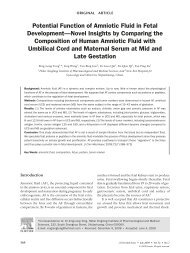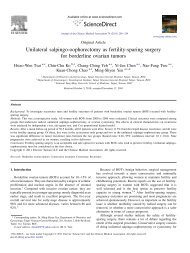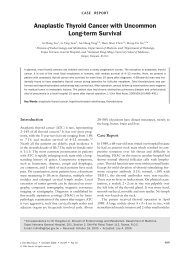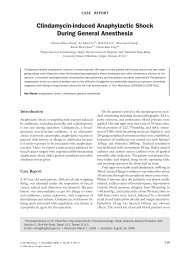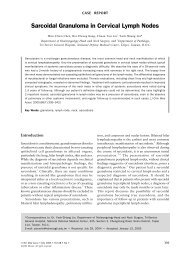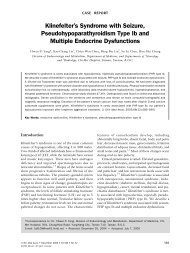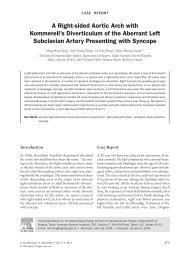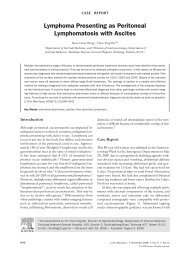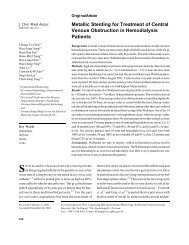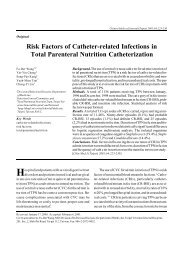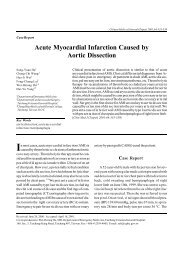Surgical Anatomy of Supratentorial Midline Lesions
Surgical Anatomy of Supratentorial Midline Lesions
Surgical Anatomy of Supratentorial Midline Lesions
Create successful ePaper yourself
Turn your PDF publications into a flip-book with our unique Google optimized e-Paper software.
FIGURE 8. Medial surface <strong>of</strong> the right cerebral hemisphere. The posterior portion <strong>of</strong> the corpus callosum is shown. A, The proximal type <strong>of</strong><br />
posterior pericallosal artery arises from the parieto-occipital artery ( poa), runs to the splenium( S), and divides into two main branches. The<br />
superior branch (black arrow) courses within the callosal sulcus with a characteristic tortuousity. The inferior branch ( white arrow) is thin and<br />
short and supplies the fasciolar gyrus and the crus <strong>of</strong> the fornix ( F). The accessory posterior pericallosal artery ( open arrow) arises from the<br />
precuneal branch <strong>of</strong> the parieto-occipital artery and runs to the callosal sulcus. B, body <strong>of</strong> corpus callosum; C, cuneus; ca, calcarine artery;CG,<br />
cingulate gyrus; M, midbrain;P, pulvinar <strong>of</strong> thalamus; PB, pineal body; PC, precuneus. B, after partial removal <strong>of</strong> the cingulate gyrus, the<br />
pericallosal pial plexus( PP) is revealed within the callosal sulcus. Forceps lift the posterior pericallosal artery to show more clearly the<br />
anatomy <strong>of</strong> its superior ( black arrow) and inferior (white arrow) branches. The superior branch and the accessory posterior pericallosal artery<br />
(open arrow) anastomose with the posterior extension <strong>of</strong> the A5 segment and form the dense portion <strong>of</strong> the pericallosal pial plexus. C,<br />
cuneus;ca, calcarine artery; F, fornix;P, pulvinar <strong>of</strong> thalamus; PB, pineal body; poa, parieto-occipital artery; S, splenium.<br />
FIGURE 9. Medial surface <strong>of</strong> the right cerebral hemisphere. The midbrain ( M) has been cut. The posterior portion <strong>of</strong> the corpus callosum is<br />
shown. The distal type <strong>of</strong> posterior pericallosal artery arises from the precuneal branch <strong>of</strong> the parieto-occipital artery( poa) and runs to the<br />
splenium(S), where it divides into two main branches. The superior branch ( white arrow) courses within the callosal sulcus. The inferior<br />
branch (black arrow) runs anteriorly then gives rise to branches to the tela choroidea <strong>of</strong> the third ventricle ( TV). F, fornix;LG, lingual gyrus;<br />
LV, lateral ventricle; PB, pineal body; PC, precuneus.<br />
In addition to the posterior pericallosal artery, a very fine artery that contributed to the blood supply <strong>of</strong> the splenium was observed in 25%<br />
<strong>of</strong> the hemispheres. It originated from the precuneal branch <strong>of</strong> the parieto-occipital artery, the hippocampal artery, the medial posterior choroidal<br />
artery, or the lateral posterior choroidal artery. Its diameter ranged from 0.2 to 0.4 mm(average, 0.3 mm). We have named this artery the<br />
“accessory posterior pericallosal artery" (Figs. 8, A and B, and 11).



